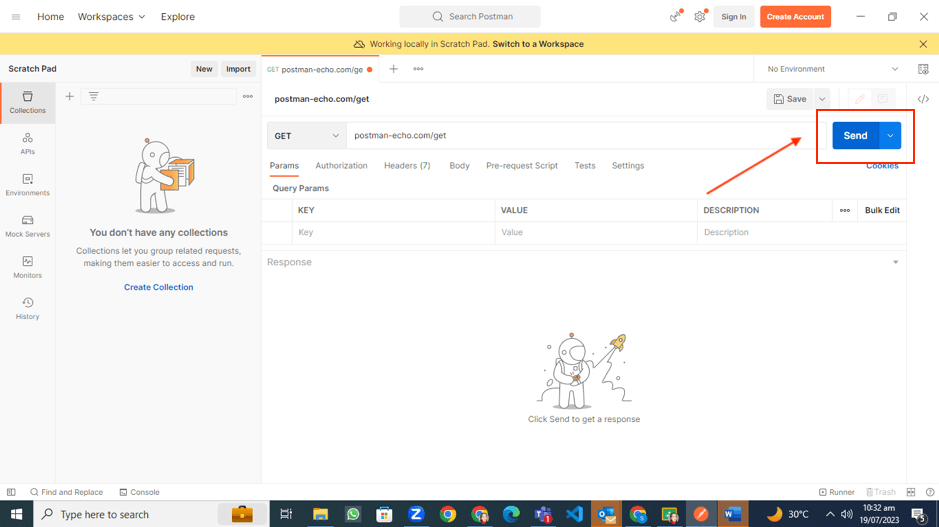Postman is a popular collaboration platform for API development used by developers all over the world. It is a powerful tool that simplifies the process of testing, documenting, and sharing APIs.
Postman provides a user-friendly interface that enables developers to interact with RESTful APIs and streamline their API development workflow. In this blog post, we will discuss the different HTTP methods, and how they can be used with Postman.

HTTP Methods
HTTP methods are used to specify the type of action that needs to be performed on a resource. There are several HTTP methods available, including GET, POST, PUT, DELETE, and PATCH. Each method has a specific purpose and is used in different scenarios:
- GET is used to retrieve data from an API.
- POST is used to create new data in an API.
- PUT is used to update existing data in an API.
- DELETE is used to delete data from an API.
- PATCH is used to partially update existing data in an API.
1. GET Method
The GET method is used to retrieve information from the server. It is the most used HTTP method and is used to retrieve data from a server.
In Postman, you can use the GET method to retrieve data from an API endpoint. To use the GET method, you need to specify the URL in the request bar and click on the Send button. Here are step-by-step instructions for making requests using GET:
In this tutorial, we are using the following URL:
Step 1:
Create a new request by clicking + in the workbench to open a new tab.
Step 2:
Enter the URL of the API that we want to test.
Step 3:
Select the “GET” method.

Click the “Send” button.
2. POST Method
The POST method is used to send data to the server. It is commonly used to create new resources on the server. In Postman, you can use the POST method to send data to the server. To use the POST method, you need to specify the URL in the request. Here are step-by-step instructions for making requests using POST
- Create a new request.
- Enter the URL of the API that you want to test.
- Select the “POST” method.
- Add any additional headers or parameters to the request.
- Click the “Send” button.
3. PUT Method
PUT is used to update existing data in an API. In Postman, you can use the PUT method to update existing data in an API by selecting the “PUT” method from the drop-down menu next to the “Method” field.
You can also add data to the request body by clicking the “Body” tab and selecting the “raw” radio button. Here are step-by-step instructions for making requests using PUT
- Create a new request.
- Enter the URL of the API that you want to test.
- Select the “PUT” method.
- Add any additional headers or parameters to the request.
- Click the “Send” button.
4. DELETE Method
DELETE is used to delete existing data in an API. In Postman, you can use the DELETE method to delete existing data in an API by selecting the “DELETE” method from the drop-down menu next to the “Method” field. Here are step-by-step instructions for making requests using DELETE
- Create a new request.
- Enter the URL of the API that you want to test.
- Select the “DELETE” method.
- Add any additional headers or parameters to the request.
- Click the “Send” button.
5. PATCH Method
PATCH is used to partially update existing data in an API. In Postman, you can use the PATCH method to partially update existing data in an API by selecting the “PATCH” method from the drop-down menu next to the “Method” field.
You can also add data to the request body by clicking the “Body” tab and selecting the “raw” radio button. Here are step-by-step instructions for making requests using PATCH:
- Create a new request.
- Enter the URL of the API that you want to test.
- Select the “PATCH” method.
- Add any additional headers or parameters to the request.
- Click the “Send” button.
Why Postman and Python are useful together
With the Postman Python library, developers can create and send requests, manage collections and environments, and run tests. The library also provides a command-line interface (CLI) for interacting with Postman APIs from the terminal.
How does Postman work with REST APIs?
- Creating Requests: Developers can use Postman to create HTTP requests for REST APIs. They can specify the request method, API endpoint, headers, and data.
- Sending Requests: Once the request is created, developers can send it to the API server. Postman provides tools for sending requests, such as the “Send” button, keyboard shortcuts, and history tracking.
- Testing Responses: Postman receives responses from the API server and displays them in the tool’s interface. Developers can test the response status, headers, and body.
- Debugging: Postman provides tools for debugging REST APIs, such as console logs and response time tracking. Developers can easily identify and fix issues with their APIs.
- Automation: Postman allows developers to automate testing, documentation, and other tasks related to REST APIs. Developers can write test scripts using JavaScript and run them using Postman’s test runner.
- Collaboration: Postman allows developers to share API collections with team members, collaborate on API development, and manage API documentation. Developers can also use Postman’s version control system to manage changes to their APIs.
Wrapping up
In summary, Postman is a powerful tool for working with REST APIs. It provides a user-friendly interface for creating, testing, and documenting REST APIs, as well as tools for debugging and automation. Developers can use Postman to collaborate with team members and manage API collections or developers working with APIs.
Written by Nimrah Sohail



